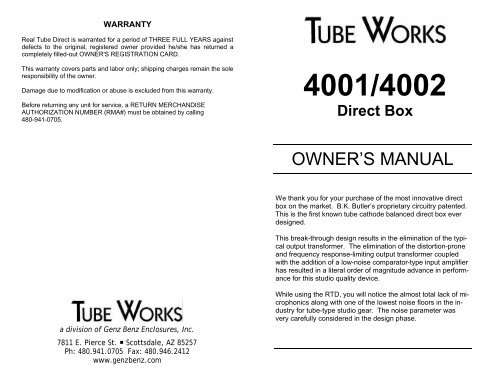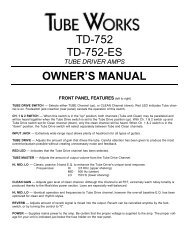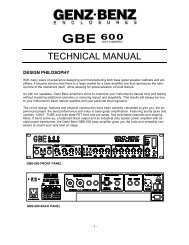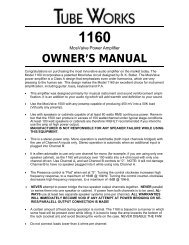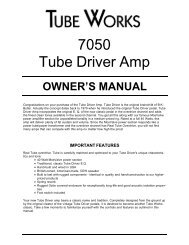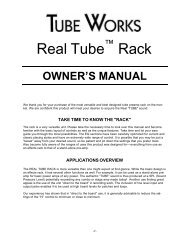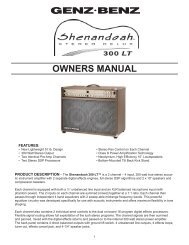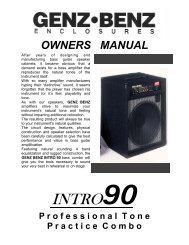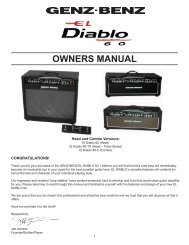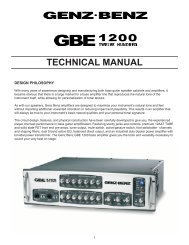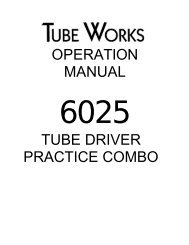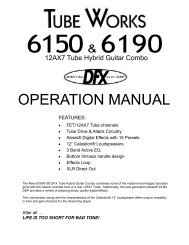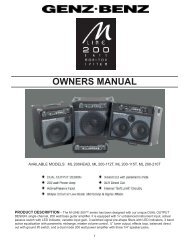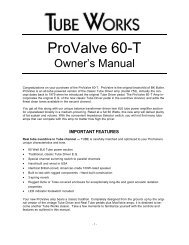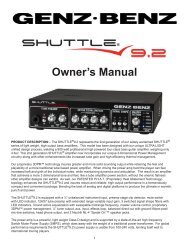Real Tube Direct - Genz Benz
Real Tube Direct - Genz Benz
Real Tube Direct - Genz Benz
Create successful ePaper yourself
Turn your PDF publications into a flip-book with our unique Google optimized e-Paper software.
WARRANTY<br />
<strong>Real</strong> <strong>Tube</strong> <strong>Direct</strong> is warranted for a period of THREE FULL YEARS against<br />
defects to the original, registered owner provided he/she has returned a<br />
completely filled-out OWNER'S REGISTRATION CARD.<br />
This warranty covers parts and labor only; shipping charges remain the sole<br />
responsibility of the owner.<br />
Damage due to modification or abuse is excluded from this warranty.<br />
Before returning any unit for service, a RETURN MERCHANDISE<br />
AUTHORIZATION NUMBER (RMA#) must be obtained by calling<br />
480-941-0705.<br />
4001/4002<br />
<strong>Direct</strong> Box<br />
OWNER’S MANUAL<br />
We thank you for your purchase of the most innovative direct<br />
box on the market. B.K. Butler’s proprietary circuitry patented.<br />
This is the first known tube cathode balanced direct box ever<br />
designed.<br />
This break-through design results in the elimination of the typical<br />
output transformer. The elimination of the distortion-prone<br />
and frequency response-limiting output transformer coupled<br />
with the addition of a low-noise comparator-type input amplifier<br />
has resulted in a literal order of magnitude advance in performance<br />
for this studio quality device.<br />
a division of <strong>Genz</strong> <strong>Benz</strong> Enclosures, Inc.<br />
7811 E. Pierce St. ◦ Scottsdale, AZ 85257<br />
Ph: 480.941.0705 Fax: 480.946.2412<br />
www.genzbenz.com<br />
While using the RTD, you will notice the almost total lack of microphonics<br />
along with one of the lowest noise floors in the industry<br />
for tube-type studio gear. The noise parameter was<br />
very carefully considered in the design phase.
WHY USE A DIRECT BOX?<br />
The output impedance from your instrument (guitar, bass, etc.) is traditionally<br />
quite high impedance. This means that a relatively small electrical disturbance<br />
(hum and static from fluorescent lights, or proximity to power AC<br />
lines, for example) can sometimes get into your signal line and then be<br />
amplified along with the good musical signal you want. Additionally, high<br />
impedance is prone to capacitive losses in the guitar cord itself, reducing<br />
the high-end response of your instrument.<br />
The RTD will convert your instrument's high impedance output to a very<br />
low (less than 100 ohms) output. This output can then be sent through a<br />
much longer cable (50 feet is not uncommon) without any additional hum<br />
pick-up or high end losses. Your instrument will be noticeably brighter and<br />
actually more "direct" sounding. Conversion to low impedance makes the<br />
musical electrical signal virtually immune from outside interference.<br />
In addition to providing low impedance output, your RTD also converts<br />
your single-ended (2-wire) instrument signal into a professional true balanced<br />
(3-wire) microphone level send for direct connection to the microphone<br />
input of a mixing console.<br />
The above-mentioned functions of the RTD are pretty typical of most garden-variety<br />
direct Boxes. What is not typical of the RTD vs. other typical<br />
direct boxes is the incredible REAL TUBE tonal enhancement the RTD<br />
gives your instrument!! All outputs are direct "Class A” tube. Be forewarned:<br />
after experiencing the RTD, other direct boxes will fail to satisfy.<br />
SPECIFICATIONS<br />
Input Voltage Range ….…………………………………. 0 to 3.8 Volts RMS<br />
(45 Volts max. In "SPEAKER” mode)<br />
Max. Output Voltage (Unity) …....................………………... 3.8 Volts RMS<br />
(Normal, Balanced) .. .......………….. 0.5 Volts/phase ref. to pin 1<br />
(1.0 Volts, differential)<br />
Output Impedance ……………………………….Line & Balanced: 100 ohms<br />
(Usually 65 is best)<br />
Signal/Noise Ratio …………………………………………...Better than 90dB<br />
Hum & Noise ……………...……….Better than -75dB (unweighted, no load)<br />
Distortion (THD) ................…………….…....Less than .05% (usually .oq%)<br />
Liberal depends on weighting<br />
Frequency Response .......….………...….15 Hz - 50,000 KHz (+/- 0.25dB)<br />
x unheard of tenth 20-40 flat tenth of a dB<br />
Power Requirement ...............…………………. 30 VAC, 600mA (External)<br />
<strong>Tube</strong> Complement ...………...12AX7A (selected and each section marked<br />
FEATURES<br />
BOOST/NORMAL SWITCH — Boosts BALANCED output from -24dB to -<br />
12dB (differentially NORMAL measured) below input level Selection depends<br />
on the SWITCH sensitivity of the mixing board being connected to as<br />
well as its SIN ratio characteristics. You need to experiment with this switch<br />
set in either position and then adjust the mixer's input pad for the best SIN<br />
ratio and headroom (or clipping limit). NOTE: This switch DOES NOT affect<br />
the 1/4" OUTPUT jack level. The OUTPUT jacks is ALWAYS at unity gain<br />
level (same level as INPUT).<br />
LIFT/ GROUND SWITCH — Lifts and isolates the DC common ground<br />
(input and case ground) from pin 1 of the BALANCED output connector.<br />
Select the position which results in the least hum.<br />
POWER/ON SWITCH — Supplies power to internal circuits. The green LED<br />
indicates SWITCH power "on".<br />
SPEAKER/ NORMAL — Used to select normal (instrument input) mode or<br />
create a line or mic-level send from the speaker output of an instrument amplifier.<br />
To use in speaker mode: Plug output from amplifier to INPUT jack.<br />
Set switch to "SPEAKER". Plug speaker into SPEAKER/LOOP OUT jack.<br />
Signal available at the OUTPUT jack and the BALANCED will be an isolated<br />
signal with a smooth high frequency roll-off to compensate for the typical<br />
boost that is built into amplifier and is necessary for instrument speakers.<br />
This set up allows you to get the entire sound of your instrument plus your<br />
amplifier into the output of the RTD.<br />
SIDE PANELS (left to right)<br />
INPUT — Accepts a wide range of instrument to line level inputs. Input impedance<br />
is 1 Meg. Ohm. NOTE: Be sure "Speaker/Normal" switch is set to<br />
Normal position when using instrument inputs. Use Speaker position only<br />
when connecting to an amplifier's output. (See information under previous<br />
heading "SPEAKER/NORMAL”).<br />
SPEAKER/LOOP OUT — Simply a hard-wired signal loop out which is identical<br />
to the signal fed into the INPUT jack. Connects to speaker (when RTD<br />
is used with an amplifier in "speaker" mode).<br />
OUTPUT — Unity-gain <strong>Real</strong> <strong>Tube</strong> <strong>Direct</strong> output. Typically this jack would be<br />
connected to your combo amplifier's input jack.<br />
TRUE BALANCED — True balanced type output for typical connection to a<br />
microphone on a level input on a mixing console.


